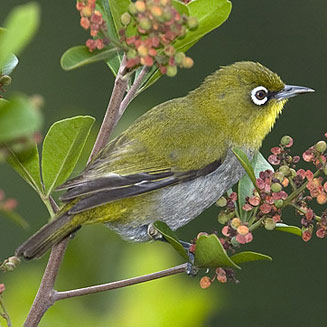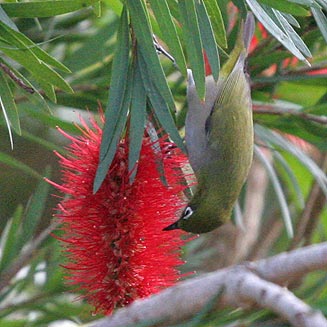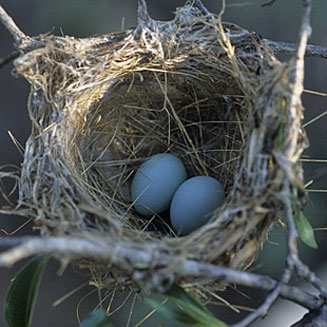|
Zosterops virens (Cape white-eye)
[= Zosterops pallidus]
Kaapse glasogie [Afrikaans]; Intukwane [Xhosa]; umBicini,
uMehlwane [Zulu]; Setona-mahloana [South Sotho]; Manqiti (generic term for
white-eye) [Tsonga]; Kaapse brilvogel [Dutch]; Zostérops du Cap [French];
Oranjebrillenvogel [German]; Olho-branco do Cabo [Portuguese]
Life
> Eukaryotes >
Opisthokonta
> Metazoa (animals) >
Bilateria >
Deuterostomia > Chordata >
Craniata > Vertebrata (vertebrates) > Gnathostomata (jawed
vertebrates) > Teleostomi (teleost fish) > Osteichthyes (bony fish) > Class:
Sarcopterygii (lobe-finned
fish) > Stegocephalia (terrestrial
vertebrates) > Tetrapoda
(four-legged vertebrates) > Reptiliomorpha > Amniota >
Reptilia (reptiles) >
Romeriida > Diapsida > Archosauromorpha > Archosauria >
Dinosauria
(dinosaurs) > Saurischia > Theropoda (bipedal predatory dinosaurs) >
Coelurosauria > Maniraptora > Aves
(birds) > Order: Passeriformes
> Family: Zosteropidae
 |
 |
|
Cape white-eye. [photo
Johann Grobbelaar ©] |
Cape white-eye feeding on Callistemon,
Grootvadersbos, Western Cape, South Africa. [photo H. Robertson, Iziko
©] |
Distribution and habitat
Near-endemic to South-Africa, occurring across much of the
country, excluding the Kalahari Desert and extending into south-eastern
Botswana. It is very common in a wide variety of habitats, including Karoo,
fynbos, suburban gardens and parks, evergreen forest, dune scrub, Acacia
veld and Eucalyptus plantations.
Predators and parasites
It has been recorded as prey of the following birds:
Brood parasites
It has been recorded as host of the
Jacobin cuckoo.
Food
It eats a variety of invertebrates (especially aphids),
fruit and nectar, foraging in pairs or small parties year-round. It mainly
gleans prey from leaves and branches, occasionally plucking an insect from the
air or ground. The following food items have been recorded
in its diet:
- Invertebrates
- Fruit
- figs
- Ficus salicifolia (Wonderboom fig)
- Ficus sur (Broom-cluster fig)
- Ficus petersii (Peters fig)
- Kiggelaria africana (Wild peach)
- Olea capensis (Ironwood)
- Schinus molle (Pepper-tree)
- Coteanaster
-
Pyracantha
- Lantana camara (Cherry-pie)
- apricots
- mulberries (Morus)
- grapes
- plums
- pears
- blackberries
- oranges
- Nectar
-
Aloe ferox (Bitter aloe)
- Aloe pluridens (French aloe)
- Diospyros pubescens (Jackal-berry)
- Scutia myrtina (Cat-thorn)
- Poinsettia
- Erythrina (Coral-trees)
- Callistemon (alien Bottle-brushes)
- Grevillea robusta (Silky oak)
Breeding
- Both sexes construct the nest (see image below) in about 5-9 days; it is a
small cup built of materials collected near the nest site, such as Usnea
barbata (Old man's beard), dry grass, rootlets, tendrils and other dry
plant fibres, bound together with spider's web. It is typically concealed in
the foliage of a tree or bush, slung between a few branches and well hidden.
 |
|
Cape white-eye at nest with chicks. [photo Peter
Steyn ©] |
 |
|
|
Cape white-eye nest with eggs, Sericea
farm, South Africa. [photo Warwick Tarboton ©] |
|
- Egg-laying season is from August-April, peaking from October-December.
- It lays 2-4 eggs, which are incubated by both sexes for about 10-12
days.
- Both parents brood and feed the chicks, who leave the nest after about
12-13 days. They remain in the foliage surrounding the nest for some time;
during this period they are very vulnerable to predator attacks.
Threats
Not threatened, in fact it is greatly benefited from the
introduction of suburban gardens.
References
-
Hockey PAR, Dean WRJ and Ryan PG 2005. Roberts
- Birds of southern Africa, VIIth ed. The Trustees of the John Voelcker
Bird Book Fund, Cape Town.
|
